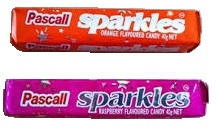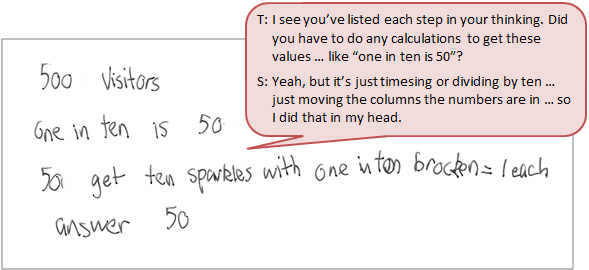The purpose of this activity is to engage students in recognising place value and using knowledge of multiplying and dividing by multiples of ten to solve a problem.
This activity assumes the students have experience in the following areas:
- Multiplying and dividing whole numbers by ten.
- Applying the place value of whole numbers.
- Working with simple decimals.
The problem is sufficiently open ended to allow the students freedom of choice in their approach. It may be scaffolded with guidance that leads to a solution, and/or the students might be given the opportunity to solve the problem independently.
The example responses at the end of the resource give an indication of the kind of response to expect from students who approach the problem in particular ways.

Sparkles were a very popular form of boiled lolly, last century, that came in packs of ten.
To celebrate days gone by, a museum is giving out a packet of 'sparkles' to one in every ten of its next five hundred visitors.
If one tenth of all of the sparkles are broken, how many broken sparkles are given out altogether?
The following prompts illustrate how this activity can be structured around the phases of the Mathematics Investigation Cycle.
Make sense
Introduce the problem. Allow students time to read it and discuss in pairs or small groups.
- Do I understand the situation and the words? (Students may need support to understand the equivalent meaning of the phrases “one in ten” and “one tenth.”)
- Can I underline the important information needed to solve the problem?
- What will my solution look like? (The solution will be the number of broken sparkles supported by calculations and explanations.)
Plan approach
Discuss ideas about how to solve the problem. Emphasise that, in the planning phase, you want students to say how they would solve the problem, not to actually solve it.
- What strategies will be useful to solve a problem like this?
- What maths knowledge will be useful?
- How will I record my thinking in helpful ways?
- What tools (digital or physical) could help my investigation?
Take action
Allow students time to work through their strategy and find a solution to the problem.
- Am I showing my workings in a clear, organised way?
- Are my strategies working or should I try something else?
- Do I need some support from other people?
- How am I checking my calculations?
- How do my results look different or different to others? Why could this be?
- Do I have more efficient ways to solve the problem?
Convince yourself and others
Allow students time to check their answers and then either have them pair share with other groups or ask for volunteers to share their solution with the class.
- What is my answer?
- Is my working clear for someone else to follow?
- How would I convince someone else I am correct? How?
- What different ways can I find to solve the problem?
- What maths did I learn while solving the problem?
- How might that maths be useful in other situations?
Examples of work
Work sample 1
The student recognises that “one in ten” means one-tenth so calculate 500 ÷ 10 = 50 to find out how many visitors get a packet. They also recognise that one-tenth of ten equals one, so each packet holds one broken lolly on average. Creating the rate 1 packet: 1 broken lolly they conclude 50 broken lollies are in the packets.
Click on the image to enlarge it. Click again to close.
Work sample 2
The student calculates how many sparkles in total are given out using multiplication. They then find one-tenth of 500 to get the correct answer of 50.

